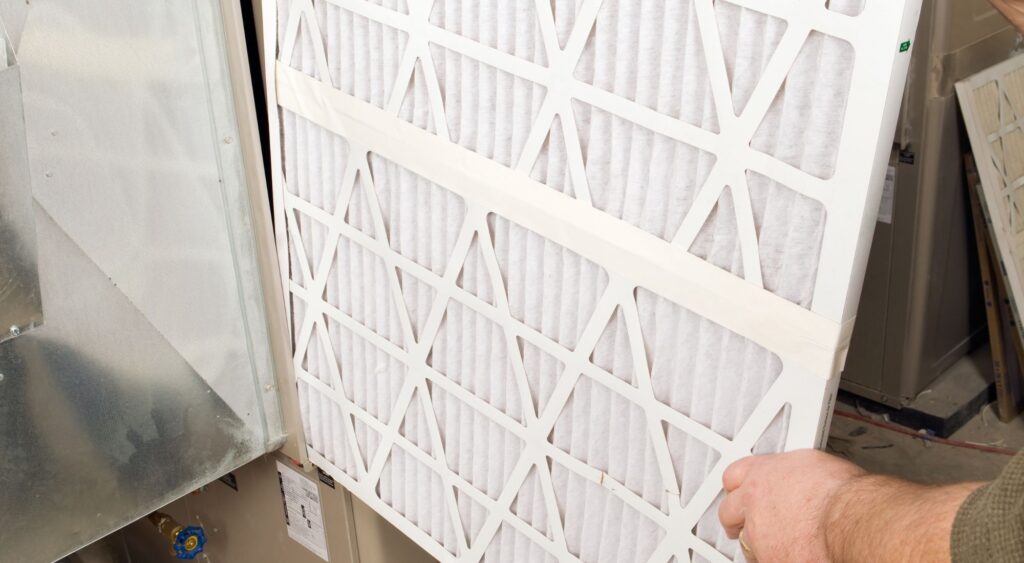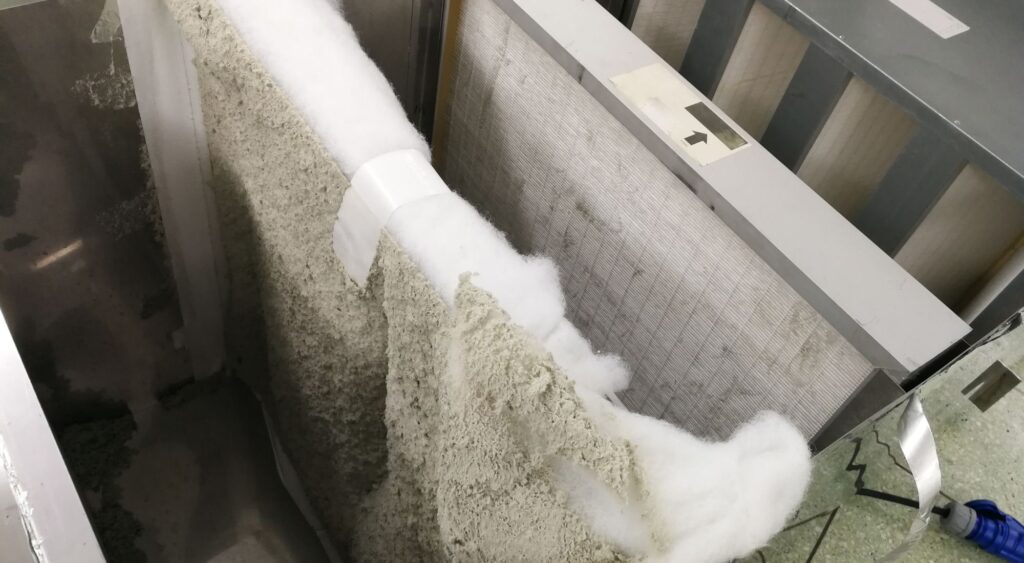
Published June 12, 2024 by Tony Spezza
Using the right air filter for your HVAC system is a great way to ensure the air quality in your home is as healthy as possible, but with so many choices available, how do you know which air filter is right for your HVAC system?
Choosing the right air filter goes beyond simply picking a type, though. You should also assess the different air filter ratings to make the best choice for your home.
Learn about the different air filter ratings and the various types of air filters available for your HVAC system to make your home’s air quality as healthy as possible.
Table of Contents
- Air Filter Ratings: MERV vs. MPR vs. FPR
- 5 Types of Air Filters To Choose From
- Let the Experts at AAA Heating & Cooling Guide You on the Best Air Filter Choice for Your Home Based on Air Filter Ratings
Air Filter Ratings: MERV vs. MPR vs. FPR
The quality of an air filter is determined by its rating which tells you the filter’s capacity to block the particles in the air from circulating throughout your home. The higher the air filter rating, the smaller the air and dust particles your home’s AC air filter can capture, making for better indoor air quality.
The best air filters with the highest ratings work against a wide range of airborne particles, including:
- Dust
- Pollen
- Smoke
- Bacteria
- Dander
- Odors
- Hair
- Airborne viruses
Airborne particles are measured in microns — ranging from microscopic to visible to the human eye — which help determine how easily they can be inhaled if a filtration system cannot trap them.
When shopping for air filters, you’ll notice three common air filter rating types:
- MERV
- MPR
- FPR
What Is a MERV Rating?
Established by the American Society of Heating, Refrigerating, and Air Conditioning Engineers (ASHRAE), MERV ratings — Minimum Efficiency Rating Value — are available on all air filters in the United States because it’s the only nationally regulated rating system for air filters.
A MERV rating specifies the filter’s ability to capture air particles and pollutants. Although MERV ratings run on a scale of 1-20, they typically read 8, 11, 13, or OE. The higher the MERV rating, the more particles it can capture.
- 8 MERV: Best in standard residential and commercial buildings for healthy families; captures 90% of airborne particles
- 11 MERV: Best in superior residential and commercial buildings for those who suffer from allergies; captures 95% of airborne particles
- 13 MERV: Best in optimal residential and commercial (hospital grade) buildings for those with asthma and other respiratory issues; captures 98% of airborne particles
- OE (Odor Eliminator): Best in standard residential and commercial buildings for healthy families; captures 90% of airborne particles
What Is an MPR Rating?
MPR — Microparticle Performance Rating — measures the air filter’s ability to trap air particles smaller than one micron. Ratings typically range from 300 MPR to 2800 MPR.
Consider these various MPR ratings, for example:
- 100 MPR:
- Lint
- Household dust
- 1500 MPR:
- Lint
- Household dust
- Dust mite debris
- Mold spores
- Pollen
- Pet dander
- Smoke
- Cough & sneeze particles
- Bacteria
- Viruses
- 2800 MPR:
- Lint
- Household dust
- Dust mite debris
- Mold spores
- Pollen
- Pet dander
- Smoke
- Cough & sneeze particles
- Bacteria
- Viruses
- Candle soot
- PM 2.5 air pollution
- Exhaust particles
- Ultrafine particles
What Is an FPR Rating?
FPR — Filter Performance Rating — is a rating system created by and specific to The Home Depot for brands sold only in their stores. The FPR rating system uses a number scale from 4-10 and a color code to rate the filter’s quality and ability to trap certain particles, including:
- 4-5 (Good): Filters out larger particles like dust, dust mites, larger pollen particles, and pet dander
- 6-7 (Better): Filters out the same larger particles plus smaller particles like bacteria and mold spores
- 8-9 (Best): Filters out both the larger and smaller particles but also removes smoke, smog, allergens, and particles that carry viruses
- 10 (Premium): Filters out all the above particles plus odor-causing particles
5 Types of Air Filters To Choose From
Now that you understand the different air filter rating systems, it’s time to find an air filter. But before you start shopping, be sure to measure your space or refer to your HVAC manual or the manufacturer’s specifications to save you time and hassle.
#1: Disposable Vent Filters
Disposable vent filters utilize electrostatic register filtration, a process that uses the vent filter’s electrostatic material to act as a magnet to attract dust.
Disposable vent filters keep microscopic particles from getting through the filter, ensuring the air quality in your home remains fresh and clear of pollutants. It traps things like:
- Cigarette smoke
- Odors
- Dust
- Pollen
If you have family members who suffer from allergies or there are other odors present in the home, a disposable vent filter is a great option. Note that they should be replaced every three months.
#2: Reusable Filters
Reusable filters also use electrostatic register filtration, but because they are permanently adjustable, they require little maintenance.
The upfront cost of a reusable filter is typically more than other types, but they don’t need to be replaced. Instead, simply clean your filter as often as you’d like or need. A quick and easy wash can help you maintain the air quality of your home.
#3: Pleated Filters
These filters use larger pieces of fiberglass, polyester, and other synthetic materials that are folded into pleats to help increase surface area to trap and remove more contaminants.
Most often, pleated filters feature MERV ratings of five to 13 and work to remove about 45% of airborne particles.
Higher efficiency versions can have MERV ratings up to 16 and remove around 85% of contaminants, but note that this capacity might be too large for many HVAC systems.
Overall, pleated filters are affordable, work in many systems, and provide significant air quality improvements over disposable vents and reusable filters.
#4: HEPA Filters
Featuring MERV ratings from 17 to 20, HEPA filters are high-efficiency particulate air filters that work to remove 99.7% of contaminants. However, they also require significant pressure to force air through, making them too restrictive for many HVAC systems.
They are more expensive than other air filter options, so if you’re considering a HEPA filter, first check to be sure your HVAC system can accommodate it.
#5: The Absorber Filter
The absorber filter is mainly used for odor control and is great for homeowners who need help eliminating unpleasant smells, such as cigarette smoke. It’s also a reliable option for those with pets because it is effective in filtering out pet dander.
Let the Experts at AAA Heating & Cooling Guide You on the Best Air Filter Choice for Your Home Based on Air Filter Ratings
Searching for a quality air filter that meets high air filter ratings and will work to eliminate your home of harmful contaminants? Let the experts at AAA Heating & Cooling guide you through purchasing the best air filter for your home.
With over 62 years in business, our family-owned company has built long-lasting relationships with our customers. We take the time to listen to and understand your concerns regarding the comfort, health, and safety of your home. We also make the best recommendations possible, perform installations, repairs, and maintenance, and share our knowledge with you.
Contact AAA Heating & Cooling today to get started.



